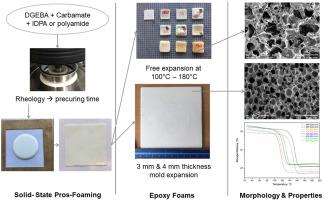Polymer ( IF 4.1 ) Pub Date : 2022-06-18 , DOI: 10.1016/j.polymer.2022.125080 Du Ngoc Uy Lan , Christian Bethke , Volker Altstädt , Holger Ruckdäschel

|
The foaming of epoxy resin is a challenge process in optimizing the flow foaming and curing to obtain a homogeneous cellular structure. This study presents a new method for preparing of epoxy foams, which is called solid-state carbamate foaming technique. The epoxy resin was formulated based on epoxy, hardener (amine or polyamide) and carbamate. The first step is to precure an epoxy resin and hardener to form a solid-state pros-foam sheet. The second steps are foaming and complete curing. Carbamate decomposes to form CO2 for foaming and revived amine for final curing. By changing the amine or polyamide hardener, and their ratio with carbamate, epoxy foam with density of 110–150 kg/m3 after free expansion was achieved. Epoxy foams with 3 mm (density of 407–434 kg/m3) and 4 mm thickness (density of 332–352 kg/m3) were expanded in a mold. The final foams have a glass transition temperature of 119–157 °C and storage modulus at 30 °C of 90–210 MPa.
中文翻译:

使用固态氨基甲酸酯发泡技术制备前泡沫板及其环氧泡沫
环氧树脂的发泡是优化流动发泡和固化以获得均匀多孔结构的挑战过程。本研究提出了一种制备环氧泡沫塑料的新方法,即固态氨基甲酸酯发泡技术。环氧树脂基于环氧树脂、硬化剂(胺或聚酰胺)和氨基甲酸酯配制而成。第一步是预固化环氧树脂和硬化剂以形成固态泡沫板。第二步是发泡和完全固化。氨基甲酸酯分解形成 CO 2用于发泡和再生胺用于最终固化。通过改变胺类或聚酰胺类固化剂及其与氨基甲酸酯的配比,实现了自由膨胀后密度为110-150 kg/m 3的环氧泡沫塑料。3 mm 的环氧泡沫塑料(密度为 407–434 kg/m 3) 和 4 mm 厚度(密度为 332–352 kg/m 3)在模具中膨胀。最终泡沫的玻璃化转变温度为 119–157 °C,30 °C 下的储能模量为 90–210 MPa。











































 京公网安备 11010802027423号
京公网安备 11010802027423号